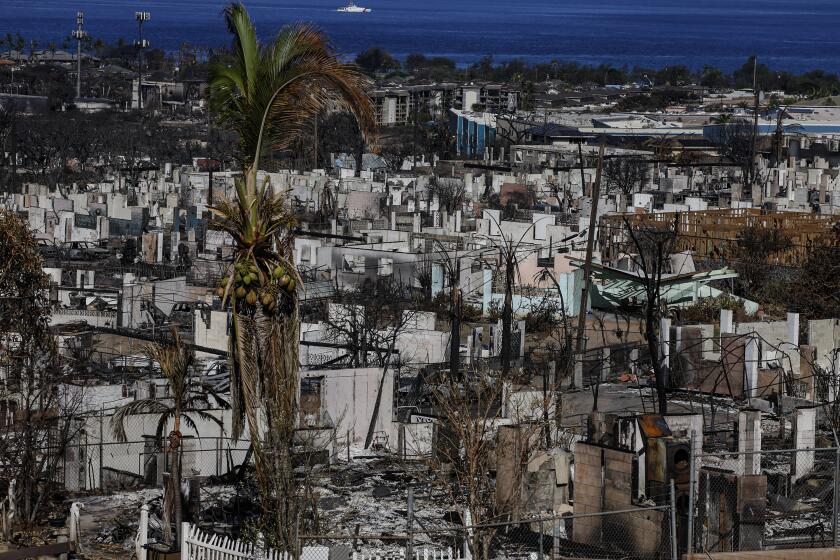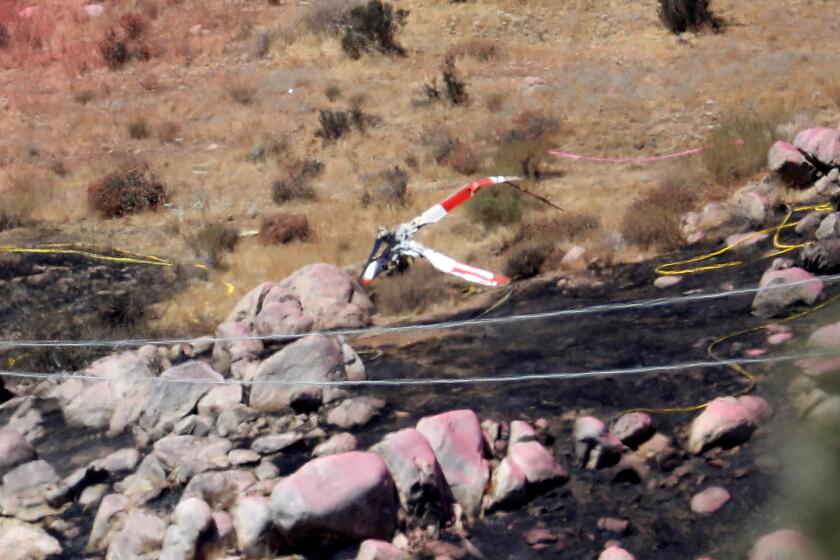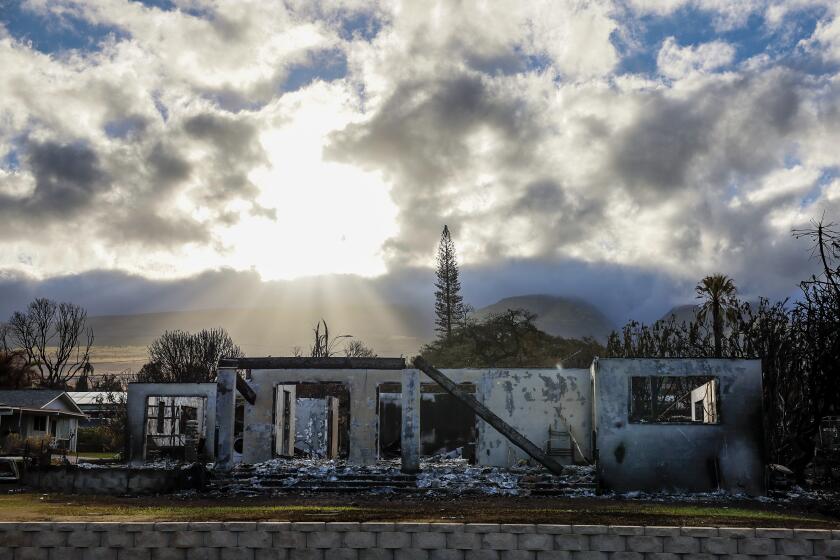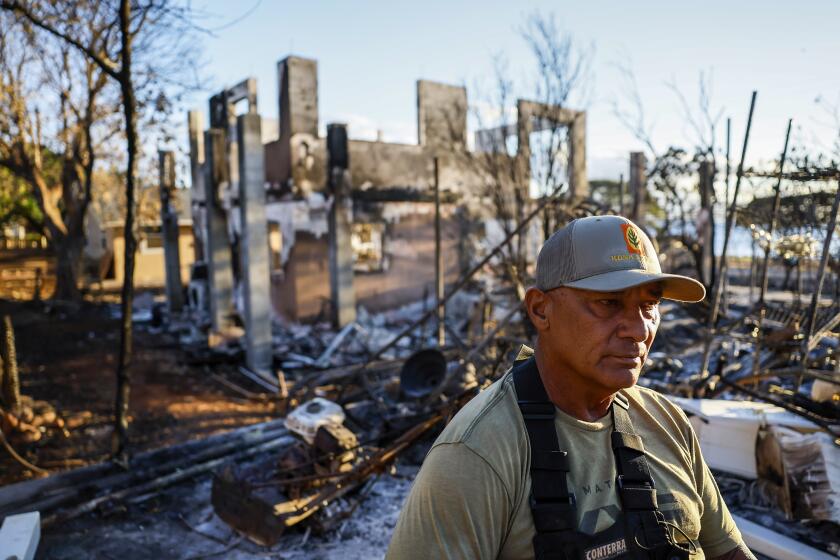The real story behind that photo of a weirdly unscathed house in the rubble of Lahaina
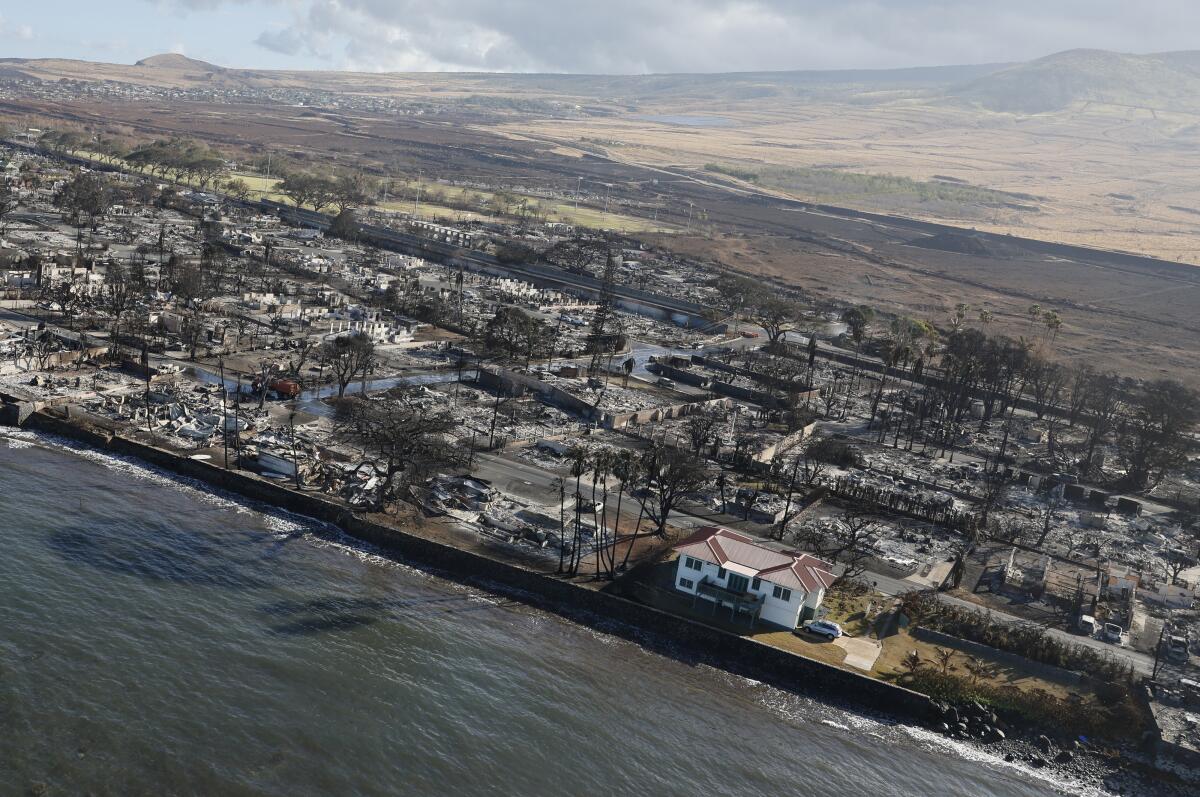
- Share via
The image has gone viral: The house, with its crisp white facade and cheerful red roof, appears untouched. Surrounding it are piles of scorched rubble left behind by the fast-moving fire that decimated Lahaina last week.
The historic Front Street home was not the only property to survive the fire. Entire subdivisions were spared as flames leapfrogged across the island. But the indelible image of the improbably unscathed house amid a backdrop of devastation is so extreme that some have questioned whether the image was digitally altered.
The situation is all too real, said Dora Atwater Millikin, who owns the house with her husband.
“We lost neighbors in this, and neighbors lost everything,” Atwater Millikin told The Times.
But their home remains, she confirmed. She’s still mulling over why.
Spiritual care teams, as well as counselors and other mental health specialists, are setting up around the island, officials said.
The couple, who was visiting family in Massachusetts when the fire started, had recently renovated the home, but not with the express goal of hardening it against flames. The 100-year-old property was once a bookkeeper’s house for employees of the Pioneer Mill Co., a sugar plantation that operated in Lahaina beginning in the mid-1800s, and the homeowners were seeking to restore some of the structure’s original features, she said.
“It’s a 100% wood house so it’s not like we fireproofed it or anything,” Atwater Millikin said.
Working closely with the county and the local historic commission, they replaced the asphalt roof with heavy-gauge metal — the home would have originally had a roof of either wooden shake or thinner-grade corrugated tin, she said. They lined the ground with stones up to the drip line of the roof, which overhangs by 36 to 40 inches.
And they removed foliage that was up against the house — not because they were trying to reduce the risk of ignition, but because they were concerned about termites spreading to the wooden frame, she said. Their only nod toward disaster preparedness was to install hurricane ties, she added.
“We love old buildings, so we just wanted to honor the building,” she said. “And we didn’t change the building in any way — we just restored it.”
It appears these modifications had the effect, however unintended, of making the home more resilient to flames.
“When this was all happening, there were pieces of wood — 6, 12 inches long — that were on fire and just almost floating through the air with the wind and everything,” Atwater Millikin said. “They would hit people’s roofs, and if it was an asphalt roof, it would catch on fire. And otherwise, they would fall off the roof and then ignite the foliage around the house.”
One of two firefighting helicopters involved in a fatal midair collision last week lacked an electronic warning device that alerts pilots to nearby aircraft.
Roofs are the No. 1 factor that contribute to the flammability of a home because they can serve as large landing pads for embers, said Susie Kocher, forestry advisor for the University of California Cooperative Extension, who co-authored a guide on how to harden homes against wildfire. In this case, a regular asphalt composition roof would likely have done just as good a job as metal, as most have a Class A fire resistance rating, she added.
That’s followed by the “near home environment” — the area immediately surrounding the structure, she said. Experts suggest that homeowners clear flammable vegetation in a 5-foot radius and replace it with a hardscape feature such as paving stones or gravel — similar to what the Millikins did, she said.
“If shrubs and bushes, especially flammable ones, are right up next to the house and embers catch them on fire, the heat can burst the window and it goes right into the home from there,” she said.
The home may also have benefited from the fact that it was not that close to neighboring properties, she said, pointing out that it was bordered on three sides by the ocean, a road and a park-like empty lot, respectively.
“One of the biggest sources of fuel is the homes,” she said. “So when one home goes up, if another is very close, the radiant heat can catch the other house.”
That risk is highest when the other building that burns is 30 feet away or less, said Stephen Quarles, UC Cooperative Extension advisor emeritus. Vulnerable components would be the siding, windows or under-eave area, as well as any foundation or attic vents, he added.
Over a week after fire incinerated Lahaina, locals are pressing for a return to work as they seek some sense of normalcy.
It appears that combustibles were largely removed from the under-deck area, and the ember exposure of the deck was lessened because it faces the ocean, he said.
“A ‘noncombustible zone’ near the home and under the deck is an excellent strategy to reduce the vulnerability of the home to a wind-blown ember exposure,” Quarles wrote in an email.
Kocher worries that surreal images such as the one of the Lahaina house can lend themselves to conspiracy theories if people don’t understand the science behind how fires spread. She recalled when Rep. Marjorie Taylor Greene (R-Ga.) speculated that the 2018 Camp fire, which killed 85 people when it destroyed the California town of Paradise, might have been started by a laser beam in space.
Already, some online commenters have suggested the survival of the Millikins’ home was evidence that the fire was actually sparked by directed energy weapons or a massive solar flare.
“I think conspiracy theories can flourish when we don’t understand how things happen,” Kocher said.
But when wildfires ignite a neighborhood, it’s fairly common for some homes to remain standing while others burn, as wind drives embers into structures’ vulnerable points or surrounding vegetation, and some houses are more resistant to embers than others, she said.
“People generally think that it’s a big wall of flames that is catching houses on fire, but often the mechanism is embers,” she said. “So embers are coming from the flaming front, which could be some distance away.”
Legendary big-wave surfer Archie Kalepa has turned his home in Lahaina into a well-orchestrated supply depot for survivors of the devastating fire.
Some have also speculated the home was saved by sprinklers, Atwater Millikin said. It did have a sprinkler system, but so did many of the other homes in the area that burned, she said. In any event, by the time the fire reached the home, the electricity was out and the system wasn’t working, she said.
Atwater Millikin is an artist who makes paintings of New England coastal scenery, and her husband is a recently retired portfolio manager. They have owned the home for about three years but lived elsewhere on Maui for about a decade, she said.
They first heard about the fire from a man who lives in Lahainaluna, a neighborhood about three and a half miles away, and uses two rooms beneath the house as a workshop. His home burned first, so he evacuated to the Millikins’. Then he had to evacuate from there, too, she said.
The county informed the couple that their house had survived in a phone call the following day, she said.
She hopes to return as soon as she can and open the place up for neighbors who have lost their homes.
“Many people have died,” she said. “So many people have lost everything, and we need to look out for each other and rebuild. Everybody needs to help rebuild.”
More to Read
Sign up for Essential California
The most important California stories and recommendations in your inbox every morning.
You may occasionally receive promotional content from the Los Angeles Times.
